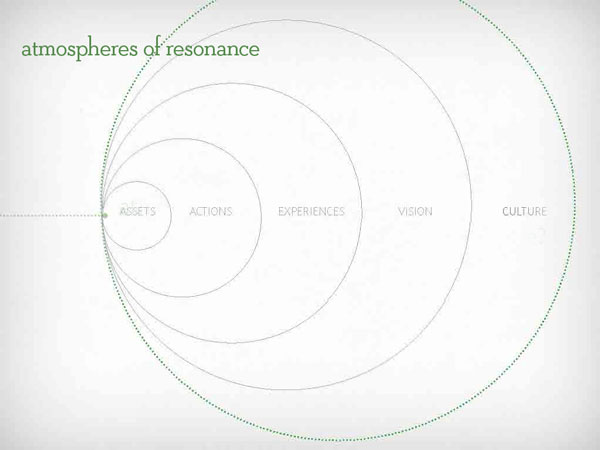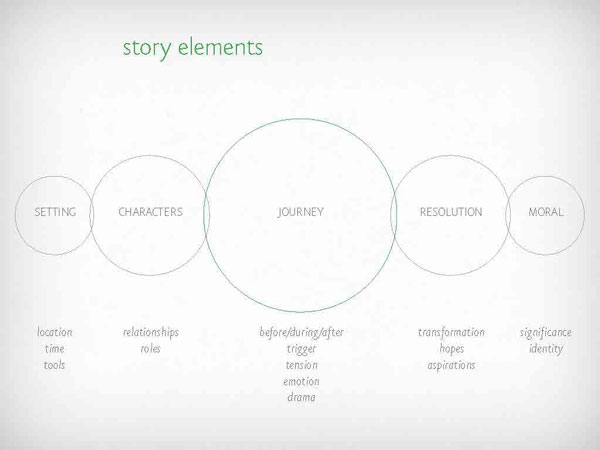This month’s Homegrown features Amber Howard, a Lecturer in the Graphic Design and Industrial Design department at NCSU and Director of Research and Education at New Kind, who spoke to us about using storytelling to find the moments that matter.
The idea of storytelling in User Experience (UX) and design is not new. But for me the way Amber approached it was. She showed us that you must design the experience of telling stories to invite people to share. This is how you find out what resonates with people. Once you know that, you can craft stories that draw people in and that they can relate to.
Below are my notes from Amber’s presentation. You can view the slides from Amber’s presentation here.
“Customers don’t know what they want until we show them.” -Steve jobs
Amber began by reminding us that, as designers we need to find common ground between multiple stakeholders. We need to get all stakeholders involved. If we don’t include the user in the process it can be disastrous. (She gave the example of the Netflix’s Qwikster blunder. They didn’t consider or consult their most important stakeholder, their customers. As result they lost 800,000 customers.)
Listening to people’s stories and finding moments that matter.
Amber advises us to involve and invite users into design process. Using stories connects with them. Making them count is the difference between belonging and rejecting, connecting and missing, believing and doubting. Use stories to understand mindsets and expectations to create designed conditions. Find ways to resonate with users. Storytelling enables us to create an overlap between mindsets and expectations designed conditions.
Make the experience count. Create to resonate.
We all tell stories—from cave paintings to telling scary stories around the campfire. We use stories to make sense of the world around us.
Make the experience of telling the story count.
Storytelling is a state of mind
Amber had us complete a little exercise to demonstrate how storytelling is a state of mind. She asked us to answer two questions:
1. What do you love being a designer?
(My answer: Problem solving, creative, learning)
2. When have you felt most fulfilled as a designer?
(My answer—and the consensus of my group: When we know we have made a positive difference of the client and they show there gratitude.)
The first question in the exercise doesn’t require a lot of effort, its a critical thinking state. The second question is the “why.” Telling the story of “why” is an emotional thinking state. It puts us in a state of mind to reveal they way we experience the world.
Invite people to tell stories to engage.
The non-conscious knows before we are aware of it.
We use metaphors to make sense of complexities. There is a non-conscious and conscious side of things. Stories are windows to the non-conscious. Telling stories gives voice to what we are experiencing in the non-conscious. Experience is the non-conscious. Consciousness is a bubbling up of non-conscious awareness.
The Iowa gambling task experiment demonstrates how the non-conscious knows before the conscious is aware. The experiment is game with two decks of cards, one deck of cards is rigged to lose. Overtime the subjects response to the rigged deck makes their heart rate increase—a physiological response leading them to recognize something was wrong with deck. Subconscious aware first as shown by the increased heart rate.
Story gets to the non-conscious side of the experience. What’s going on behind the curtain.
“If I ask people what they want they would have said faster horses.” -Henry ford
What you ask depends on how you want the design to resonate with people. There are spheres in which people find resonance.

Atmosphere of resonance
Assets:
What do people have?
What can we make?
Actions:
What do people do?
How can we streamline the process?
Experiences:
How do people relate?
How can we make it more fulfilling?
Visions:
What do they value?
How do we align perceptions?
Culture:
What do believe?
How can we expand possibility?
There is a perception that there are no assumptions behind decisions people make. If you know where they are (emotionally) and meet them where they are at , you can pull them further in.
The answers to questions we ask run a spectrum from the observable to inferential. The steps we take we take in response create a vision. The directions that we take action on in response to the answers run from the tactical to strategic.
“If I asked people to tell a story they would have surprised and inspired me is an open ended question.”
Inviting story telling:
We need to look for how we want to resonate. Which atmosphere of resonance do we want to work in? Once we know that, we are looking for moments that reveal them to us.
To facilitate storytelling you must design the experience.
Designing the experience matters in getting people to share their stories. Amber gave an example of a research study that would have yielded great data, however to gather the data required subjects to undergo an MRI—not an ideal environment. So while the results would be valuable, the experience for the subject was unpleasant. The lesson: we need to create a good environment for subject.
Facilitating a storytelling session:
- Timing is important and so is the atmosphere. After long day and while eating in a large group is not ideal.
- Control the role you play. Know your role know the encouraging and supportive persona you’re go to play.
- Create a calming environment. Provide subjects with opportunities to tell casual stories. Low stakes for telling stories. Nothing to lose when not recorded. able to build relationships with people around them.
- Give people the structure to tell great stories. It helps bring out the person and calm them, putting them at ease to open up and share.
Storytelling framework
 Setting:
Setting:
What was the situation?
Where do significant moments happen?
Reveal characters:
Who was involved?
What roles and relationships matter? Reveals what is important.
Journey:
What happened before during after?
How did emotions perceptions and form overtime?
Resolution:
How did it end?
How was tension resolved?
Who does the person want to be?
Moral:
Why did it matter?
What is valued?
What are the person’s hopes?
Design the storytelling experience
Create the setting:
- Give a set amount of time for telling the story.
- Provide a safety net for introverts? Give people a space to collect their thoughts before making it public.
- Make it social. People are more comfortable sharing stories with peers, it builds camaraderie. Find ways to record the conversation and capturing the stories. (ex. flip cams).
- Make people calm and comfortable so they are encouraged and feel comfortable sharing.
When using surveys to collect stories, design the experience to invite storytelling. Fill in the blanks questions are not conducive, asking the right questions based on the story structure will guide the participants into telling stories.
Analyzing stories:
Now that we have all these stories. How do we make sense of them? How do we use them to guide us in telling our stories in ways that resonate?
- Be sure your bias don’t sneak in
- Find themes for all the pieces
- Using grounded theory lite.
Affinity diagramming
- Get all the stories into a comparable format. Transcribe them so they are all formatted the same.
- Look for similarities use a coding system. Make dots so you can connect them. The dots should be project-specific.
- Develop a coding system so you can make dots to connect them to find commonalities. Tag transcripts with meta data or use colored sticky notes if doung the analog way.
- Use the story structure as basis for dots.
- Categorize by affinity, indenting patterns and themes to find significant moments.
- Connect dots then create a list of items of affinity and give them a title based on the commonality.
This process is called Systematic Inquiry and it helps eliminate bias.
Synthesizing stories:
To tell stories that are relevant and meaningful, use the story structure.
Belonging
Setting & Characters
- Common mindsets
- Situations and roles are found n the settings and characteristics of characters
- These becomes points of resonance
Connecting leverage points
Journey & Progression
- Before, during, and after the experience
- Commonalities and the actual journey itself
Believing purpose
Resolution & Moral
- What do people believe in?
- Values and perceptions
In conclusion
- Inviting engagement encourages people to remain engaged. It’s preferable to telling people what’s going to happen.
- Everyone has opinion
- People want to be involved and they expect it
- Methods of past don’t cut it anymore not enough to get info to design experiences that resonate
- Storytelling gets us there systematic to fu d moments that rare relevant and memorable. sense of belonging connecting meaning
- Moments that resonate.